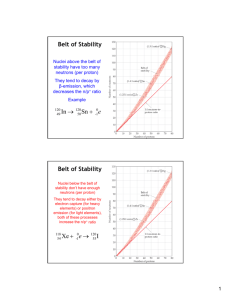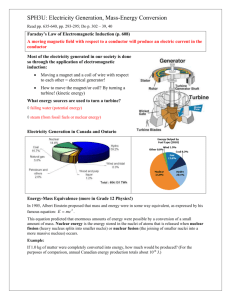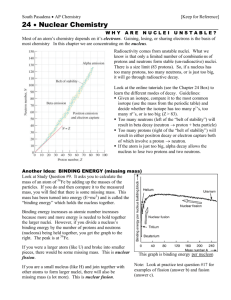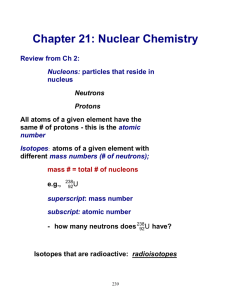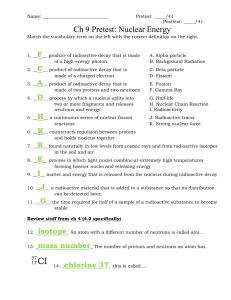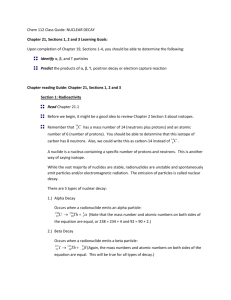Lecture 33 – Chapter 22, Sections 1
advertisement
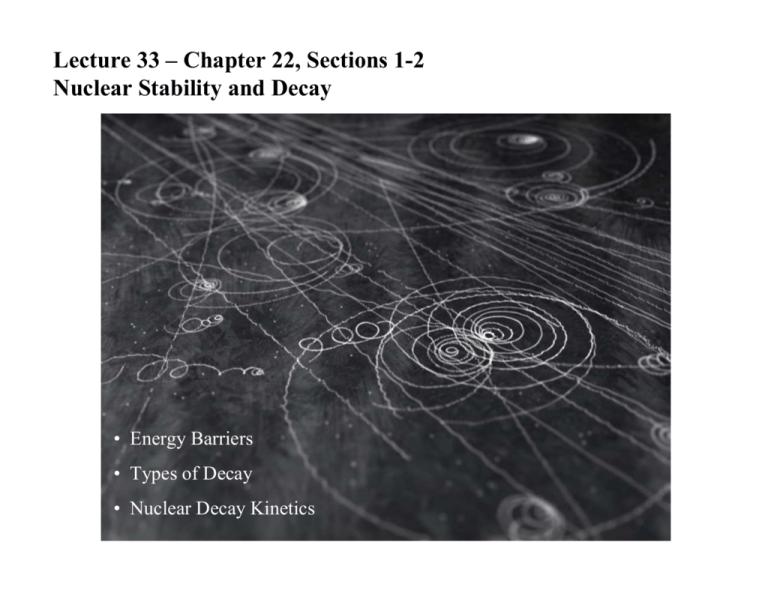
Lecture 33 – Chapter 22, Sections 1-2 Nuclear Stability and Decay • Energy Barriers • Types of Decay • Nuclear Decay Kinetics Nuclear Chemistry Nuclei Review • Nucleons: protons and neutrons • Atomic number – number of protons – identifies element • Mass number – protons + neutrons • Nuclei held together by the strong nuclear force – This force is incredibly strong – huge interaction energy – So much E is released that there is a measurable mass change E = mc2 ∆E = (∆m)c2 ∆E = ∆m × (8.988 × 1010 kJ/g) Binding Energy Example • Common isotope of helium has 2 neutrons and 2 protons. • It has an isotopic molar mass of 4.00260 g/mol – Isotopic molar mass is exact mass of this isotope, including electrons • Lone particle masses: 2(1.007276) + 2(1.008665) + 2(0.0005486) = 4.0329792 g/mol ( g ∆E = (4.00260 − 4.0329792 ) mol 8.988 ×1010 ∆E = -2.73048 ×109 kJ kJ g ) 3He has an isotopic mass of 3.0160293191 g/mol. What is the total binding energy of this nucleus? ∆E = ∆m × (8.988 × 1010 kJ/g) 25% 25% 25% 25% 1 2 – 7.4464 × 108 kJ/mol – 8.2017 × 108 kJ/mol – 8.6948 × 108 kJ/mol – 1.8206 × 1011 kJ/mol 1. 2. 3. 4. 3 4 5 Stability • If it is so energetically favorable to add nucleons to a nuclide, why doesn’t every nucleus just keep getting bigger? • Electrostatics! Eelectrostatic q1q2 =k r • For nuclei r is very, very small • So, this presents a tremendous barrier to an incoming charged nuclide • Neutrons are a little more complicated. Who’s Law is This? Eelectrostatic 20% 20% 20% 20% 20% 1 1. 2. 3. 4. 5. 2 3 Coulomb’s Einstein’s Joule’s Krueger’s Newton’s 4 5 q1q2 =k r More Stability • • • • • Large nuclei have more stable isotopes H and He have two, F one Sn has ten # protons ~ # neutrons for small neuclei # neutrons a bit greater than # protons for larger nuclei The Middle Way • The strong nuclear force is many-body. This means that 3 particles (per particle) are actually held together more strongly than two particles (per particle). – Bottom line is that larger nuclei are more stable (per particle) than smaller nuclei • However, large nuclei become unstable because of Coulombic repulsion. • So, there is a middle ground where these effects balance – Iron is the most stable nucleus. Iron = Stable • Smaller nuclei merge together to make larger ones – FUSION • Larger nuclei fall apart to become smaller – FISSION Nuclear Decay • When nuclei spontaneously change from one nuclide to another, we call this decay • Nuclides that are particularly unstable are radioactive • Nuclear reactions are very similar to chemical reactions – Mass Number is conserved (protons + neutrons), though mass is not because of E = mc2. – Charge is conserved • For instance: 1 0 n→ p + e 1 1 0 −1 – Note that sum of superscripts of reactants = products (Mass Number) – And sum of subscripts of reactants = products (Charge) Nuclear Decay Processes • • • • Variety of processes are possible when nuclei decay Some involve particle emission Some involve particle absorption Some involve energy emission Alpha Radiation • • • • Alpha particles are energetic helium nuclei (42He2+) Very heavy positively charged particles Not too dangerous Can be stopped by fabric or a couple of sheets of paper • Mass number of emitter decreases by 4 • Atomic number of emitter decreases by 2 • Occurs to nuclei that are unstable because they are too large (too many total particles) 222 86 4 Rn→ 218 Po + 84 2α 218 84 4 Po→ 214 Pb + 82 2α Belt of Stability Beta Radiation • Beta particles are electrons (0-1β–) • Very penetrating • Beta decay occurs to nuclei that lie above the belt of stability. – These nuclei have ‘too many’ neutrons – Beta decay converts neutron to proton 1 0 3 1 208 79 n→11p + −10β − H → 23He+ −10β − 0 − Au → 208 Hg + 80 −1 β Belt of Stability Positron Radiation • Positrons are anti-electrons (0+1β+) • Very penetrating • Positron decay occurs to nuclei that lie below the belt of stability. – These nuclei have ‘too many’ protons – Positron decay converts proton to neutron 1 1 18 9 144 63 p→01n+10β + F → O+ β 18 8 0 1 + 0 + Nd →144 Eu + 62 1β Belt of Stability More Positron • Positrons are not usually observed directly • When a positron and electron run into each other they annihilate – Usually there are lots of electrons around, so this happens right away – Annihilation destroys both particles (no more mass), but releases loads of energy – Energy released as two gamma rays, each of 9.87 × 107 kJ/mol Electron Capture • Absorption of electron by the nucleus • Electron removed from 1s orbital – leaves a ‘hole’ • This hole is filled by an outer electron falling down – Electron releases energy as an X-ray photon • Like positron decay, electron capture occurs to nuclei that lie below the belt of stability. – Electron capture converts proton to neutron 26 13 Al + e→ Mg 26 12 Mg * →1226Mg + hν X − ray 0 −1 26 12 * Belt of Stability Gamma Radiation • • • • Electromagnetic photons of very high energy Very penetrating can pass through the human body Require thick layers of lead or concrete to be stopped Emitted from nuclei that have excess energy – Usually from products of other nuclear decay 226 88 Ra→ 22286m Rn+ 24α 222 m 86 222 86 Rn→ Rn + γ 222 86 Rn→ 21884m Po+ 24α 218 m 84 Po→ 218 84 Po + γ Sometimes metastable (m) is denoted with a * meaning just ‘excited’ Identify the Product 214 84 20% 20% 20% 20% 20% 1 1. 2. 3. 4. 5. 2 3 Po → ? + α Polonium-210 Lead-212 Lead-210 Mercury-212 Mercury-210 4 5 Identify the product 210 82 20% 20% 20% 20% 20% 1 2 1. 2. 3. 4. 5. 3 4 Pb → Alpha particle Beta particle Positron Gamma Ray X-Ray 5 Bi + ? 210 83 Rates of Decay • Recall from Chapt 15 that nuclear decay is unimolecular – First Order – Rate = k × concentration (or often # of nuclei) c = c0 e − kt c0 ln = kt c ln 2 t 12 = k N 0 t ln 2 ln = t 12 N Today • Finish CAPA #19 • REVIEW REVIEW REVIEW!!! • Go to Neckers lecture Monday • Please please review! • Start CAPA #20 (due Wed)
